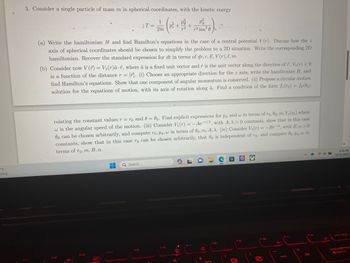Question
I just need help for part a. Question 3. (Hamilton and Lagrange formalism)

Transcribed Image Text:°F
unny
3. Consider a single particle of mass m in spherical coordinates, with the kinetic energy
1
2m
P
p² + +
7-2
P²
r² sin²0
(a) Write the hamiltonian H and find Hamilton's equations in the case of a central potential V(r). Discuss how the z
axis of spherical coordinates should be chosen to simplify the problem to a 2D situation. Write the corresponding 2D
hamiltonian. Recover the standard expression for dt in terms of dr, r, E, V(r), l, m.
(b) Consider now V(r) = V₁(r)â f, where â is a fixed unit vector and is the unit vector along the direction of F. V₁ (r) <0
is a function of the distance r = 1. (i) Choose an appropriate direction for the z axis, write the hamiltonian H, and
find Hamilton's equations. Show that one component of angular momentum is conserved. (ii) Propose a circular motion
solution for the equations of motion, with its axis of rotation along â. Find a condition of the form fr(ro) = fe(00)
IT=
relating the constant values r = ro and 0 = 0o. Find explicit expressions for po and w in terms of ro, 0o, m, V₁ (ro) where
w is the angular speed of the motion. (iii) Consider V₁(r) = -Ae-/, with A, λ> 0 constants, show that in this case
0o can be chosen arbitrarily, and compute ro, Po, in terms of 0o, m, A, A. (iv) Consider V₁ (r) = -Bra, with B, a > 0
constants, show that in this case ro can be chosen arbitrarily, that 00 is independent of ro, and compute 80, Po, w in
terms of ro, m, B, a.
-
Q Search
FS
PRE
Q
F7
*
PB
C
O
F9
FW
7
+
F12
2
6:56 PM
10/31/2023
←
Expert Solution
This question has been solved!
Explore an expertly crafted, step-by-step solution for a thorough understanding of key concepts.
Step by stepSolved in 3 steps with 6 images

Knowledge Booster
Similar questions
- 1arrow_forwardCalculate the constants b₁ and b2 in the the following equation 1 Imax d²x(t) for the condition (0) ) = xmax, the maximum extension of the oscillator. What is v(0) for this condition? Match the items in the left column to the appropriate blanks in the equations on the right. Make certain each equation is complete before submitting your answer. ?). dt² ∞ b₂ 0 t=0 dx (t) (da)₁-0 dt t=0 b₁ x(t) v(0) = xmax = b₁ co Therefore, b₁ = 0 + b₂ sin and b₂ = (√5.0) k μl • (√) +0 k COS 00 (√5-0) x(t) = b₁ cos Reset t + b₂ sin 2 sin (√) Helparrow_forwardLagrangian Dynamics Ep = 0 A pendulum of length / and mass m is mounted on a block of mass M. The block can move freely without friction on a horizontal surface as shown in the adjacent figure H. 1. Find the velocity of mass m, w.r.t the origin O 2. Write the Lagrangian of the system 3. Derive the Euler Lagrange equationsarrow_forward
- The Hamiltonian of an electron of mass m in a constant electric field E in one dimension can be written as Ĥ=+eEx where â and are the position and momentum operators, respectively. With initials conditions (t = 0) = 0 and p(t = 0) = 0, which one of the following gives (t) at time in the Heisenberg picture? You may use the commutator [â,p] = iħ. O a. O b. eEt2 2m O C. e Et O d. -eEt O e. eEt² m pt marrow_forwardplease provide detailed solutions for a to d. thank you!arrow_forwardQ1arrow_forward
arrow_back_ios
arrow_forward_ios